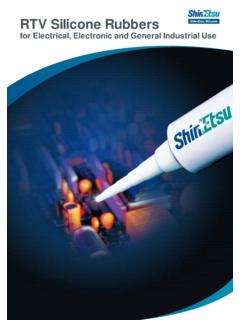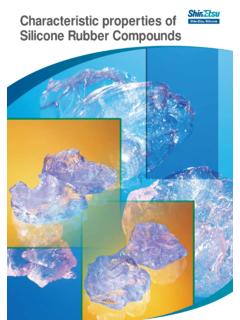Transcription of Greases Oil Compounds - Shin-Etsu Silicone
1 Greases Oil Compounds Facts about Silicone Safety Data Information on Silicone Greases Oil Compounds Packaging Product Selection Guides Precautions Related to Handling, Safety and Hygiene Product Introductions Packaging List 1. Greases . 2. Oil Compounds . Facts about Silicone Chemical properties of silicones . The main chain of a Silicone is made up of inorganic siloxane linkages (Si-O-Si), to which are attached side chains which contain organic groups. Silicones are a sort of hybrid polymer with both inorganic and organic components. Features attributable to siloxane linkages Features attributable to molecular structure Silicones have a backbone of siloxane linkages, with attached side The molecules of dimethyl Silicone exhibit a twisted, helical structure.
2 Chains which contain organic groups. Si Si O. O O. O Si Si Organic R R R groups O. O O. O. Si Si Si Si H. Si Si Si Si C H. Inorganic Si O Si O Si material O. O O. O. O. O. H. O. O H. C H. Si Si Si Si Organic Si Si H. R R R groups Si Si O. O O. O. H. O. O C. H. O. O Si Si H. Heat resistance Weatherability Water repellency Release properties Cold resistance Chemical stability Dielectric properties Low temperature-dependence Compared to organic polymers, which have a carbon skeleton (C-C bond energy: 85 kcal/mol), silicones have superior heat resistance and weatherability (UV light, ozone resistance). This is due to the greater stability of siloxane bonds, which have a bond energy of 106 kcal/mol.
3 Siloxane bonds have a bond length of and bond angle of 134 . Compared to carbon bonds (bond distance: , bond angle: 110 ), they have a long bond distance and high bond angle, and a low rotational energy barrier. As a result, siloxane bonds move more freely and intermolecular forces are weak. These characteristics manifest themselves in the features of Silicone materials, which include softness, gas permeability, cold resistance, and little change in viscosity due to temperature changes. The backbone of dimethyl Silicone exhibits a helical structure. Hydrophobic methyl groups cover almost the entire surface of the Silicone polymer molecules, and surface energy is low. This gives rise to unique properties including water repellency and easy release.
4 Moreover, silicones are low-polarity polymers, so they exhibit minimal moisture absorption. 2. Silicone Greases Oil Compounds Silicone Greases are products which consist of a base oil of Silicone fluid compounded with thickening agents (such as metallic soaps) and other additives. They can be used in a wide range of temperatures and are used primarily on moving parts to provide lubrication and adhesion. Silicone oil Compounds are products which consist of a base oil of Silicone fluid compounded with fillers such as silica powder or metallic oxides. The intended application will dictate the type of filler used. They can be used in a wide range of temperatures and are used primarily on non- moving parts for thermal conduction, electrical insulation and sealing.
5 Features of Silicone Greases Oil Compounds Because they use Silicone fluid as the base oil, Shin-Etsu Silicone Greases and oil Compounds offer the following advantages. Outstanding heat and cold resistance, so they perform well in 1 extreme conditions and will continue to do so over prolonged use. 2 Electrically insulating, so they can be used with confidence. 3 Outstanding moisture resistance and water repellency. 4 Non-corrosive. 5 Effective in small amounts. Heat resistance comparison (Left: mineral oil Right: Silicone fluid). Before using any of these products, be sure to test beforehand to determine the product's suitability to the intended application. 3. Greases Selection Guide Intended Use Application/Feature Product Name G-30F Low Temperature G-30L Applications G-30M G-30H G-40L General Purpose High Temperature Applications G-40M G-40H Lubrication Extreme High Temperature Applications G-420 High Load Applications G-302 FG-720 Solvent & Chemical FG-721 Resistant FG-722 Regular G-501 For Plastics High Load Applications G-503 Med.
6 Torque G-330 High Torque G-331 G-332 For Torque Damping Low Torque G-333 Adhesion G-334 G-340 Low Temperature G-341 Applications G-342 G-631 For Bearings Improves Feeling G-632 G-633 4. Oil compound Selection Guide Intended Use Application/Feature Product Name KS-609 General Purpose KS-613 G-747 G-775 G-776 High Reliability G-777 G-779 CLG Series Thermal G-765 Interface G-750 G-751 X-23-7762 High Thermal Conductivity X-23-7783D X-23-7868-2D G-787 X-23-7921-5 G-1000 Non-adhesive Cure Type SDP Series KS-63W General Purpose KS-64 KS-64F KS-62F Heat Resistant KS-62M High Vacuum Seals HIVAC-G Sealing KS-650N Compatible with Silicone General KS-651 KS-65A Valve Seals KS-623 Anti-rust Sealant KS-622 Electrically Conductive KS-660 Series Insulator KS-63G Optical Applications OPTSEAL Series 5.
7 Properties of grease Products Silicone Greases are made using a Silicone fluid as the base oil. This is compounded with other materials such as thickeners, oiliness improvers and antioxidants. Compared to common mineral oil Greases , Silicone Greases have greater thermo-oxidative stability and moisture resistance, and have a wider range of use temperatures. Silicone Greases are also chemically inert, and so are compatible with almost all types of equipment. Low-temperature Lubrication Applications G-30F G-30L G-30M G-30H. The Greases in the G-30 series were specially designed to provide excellent lubrication at low temperatures. There are four grades of consistency : F, L, M and H. Typical properties Parameter G-30F G-30L G-30M G-30H.
8 Appearance Grayish white paste Grayish white grease Specific gravity 25 C Consistency 25 C/worked 340 400 280 320 240 280 200 240. Drop point C 200+ 200+ 200+. Oil separation 150 C 100h % JIS K2220 Oxidative stability 150 C 50h 1 kPa 30 30 30. Test method Moisture resistance % 1 1 1. Worked stability 100,000 strokes 400 (max.) 400 (max.) 400 (max.). Low-temperature torque -60 C mN m 107/31 266/93 329/122. (Starting/Running). MIL-L15719A Low-temperature torque -60 C 2000 g-cm Less than 1 sec 1 sec 1 sec BTB Free acid or free alkali Neutral Use temperature range C 60 to +180. Volatile content 150 C 100h % Low-molecular-weight siloxane content D3-D10 ppm 100. 1 The oxidative stability test conditions prescribed in JIS K 2220 indicate 99 C 100 hours, but in this case measurement was done at 150 C 50 h.
9 (Not specified values). G-30 Greases are suitable for speed factors (bearing bore in mm _ bearing shaft speed in rpm) up to 200,000. High-temperature Lubrication Applications G-40L G-40M G-40H G-420. The Greases in the G-40 series were specially designed to provide excellent lubrication at high temperatures, and are ideal for lubrication of sealed bearings. There are three grades of consistency : L, M and H. G-420 provides outstanding lubrication at very high temperatures. Bearing lubrication Typical properties 1. Parameter G-40L G-40M G-40H G-420. Appearance Beige grease Brown grease White grease Specific gravity 25 C Consistency 25 C/worked 280 320 240 280 200 240 281. Drop point C 200+ 200+ 200+ 250+.
10 2. Oil separation 150 C 100h % 3. JIS K2220 Oxidative stability 150 C 50h kPa 10 10 10 . Test method Moisture resistance % 1 1 1 1. Worked stability 100,000 strokes 400 (max.) 360 (max.) 320 (max.) 310 (max.). Low-temperature torque -20 C mN m 66/29 83/46 117/57 41/25. (Starting/Running). MIL-L15719A Low-temperature torque -20 C 2000 g-cm Less than 5 sec. Less than 5 sec. Less than 5 sec. Less than 5 sec. BTB Free acid or free alkali Neutral Use temperature range C 30 to +200 30 to +250. Volatile content 150 C 100h % 2. Low-molecular-weight siloxane content D3-D10 ppm 100. 1 For information on safety, see page 22 (Safety & hygiene). (Not specified values). 2 200 C 24h 3 The oxidative stability test conditions prescribed in JIS K 2220 indicate 99 C 100 h, but in this case measurement was done at 150 C 50 h.







